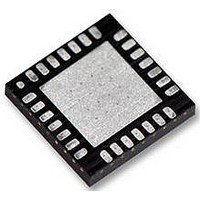LM4836LQ National Semiconductor, LM4836LQ Datasheet - Page 21

LM4836LQ
Manufacturer Part Number
LM4836LQ
Description
34C6605
Manufacturer
National Semiconductor
Datasheet
1.LM4836LQNOPB.pdf
(28 pages)
Specifications of LM4836LQ
Amplifier Class
AB
No. Of Channels
2
Output Power
2.2W
Supply Voltage Range
2.7V To 5.5V
Load Impedance
3ohm
Operating Temperature Range
-40°C To +85°C
Amplifier Case Style
LLP
Rohs Compliant
No
Available stocks
Company
Part Number
Manufacturer
Quantity
Price
Part Number:
LM4836LQ
Manufacturer:
NS/国半
Quantity:
20 000
Application Information
BASS BOOST FUNCTION
The LM4836 has a bass-boost feature that enhances the low
frequency response in applications using small speakers.
The voltage level applied to the BASS BOOST SELECT pin
controls the bass-boost function. Applying GND activates the
bass-boost mode. In bass-boost mode, the LM4836’s gain is
increased at low frequencies, with a corner frequency set by
the external capacitor, C
bass-boost mode and selects unity gain. Tying the BASS
BOOST SELECT pin to V
boost function.
Enabling bass-boost forces the output amplifiers to operate
with an internally set low frequency gain of 2 (gain of 4 in
bridged mode). The capacitor C
the bass-boost corner frequency. At low frequencies, the
capacitor is a virtual open circuit and the feedback resis-
tance consists of two 10kΩ resistors. At high frequencies,
the capacitor is a virtual short circuit, which shorts one of the
two 10kΩ feedback resistors. The results is bridge amplifier
gain that increases at low frequencies. A first-order pole is
formed with a corner frequency at
At f
With C
quency of 160Hz. It is assumed when using Equation 9 that
C
response as explained in the Proper Selection of External
Components section. See the Typical Performance Char-
acteristics section for a graph that includes bass-boost
performance with various values of C
O
, C
<<
i
, f
f
BASS
C
IC
, the differential gain of this bridged amplifier is
FIGURE 3. Headphone Sensing Circuit
, and f
= 0.1µF, the first-order pole has a corner fre-
OC
2(10kΩ + 10kΩ) /10kΩ = 4
, are chosen for the desired low frequency
f
C
= 1/(2π10kΩC
DD
BASS
permanently defeats the bass-
. Applying V
BASS
BASS
shown in Figure 1 sets
BASS
)
(Continued)
.
DD
defeats the
10108804
(10)
(9)
21
DC VOLUME CONTROL
The LM4836 has an internal stereo volume control whose
setting is a function of the DC voltage applied to the DC VOL
CONTROL pin. The volume control’s voltage input range is
0V to V
voltage = 80%V
volume remains at 0dB for DC control voltages greater than
80%V
at unity gain, bypassing the volume control. A graph showing
a typical volume response versus DC control voltage is
shown in the Typical Performance Characteristics sec-
tion.
Like all volume controls, the LM4836’s internal volume con-
trol is set while listening to an amplified signal that is applied
to an external speaker. The actual voltage applied to the DC
VOL CONTROL pin is a result of the volume a listener
desires. As such, the volume control is designed for use in a
feedback system that includes human ears and preferences.
This feedback system operates quite well without the need
for accurate gain. The user simply sets the volume to the
desired level as determined by their ear, without regard to
the actual DC voltage that produces the volume. Therefore,
the accuracy of the volume control is not critical, as long as
the volume changes monotonically, matches well between
stereo channels, and the step size is small enough to reach
a desired volume that is not too loud or too soft. Since gain
accuracy is not critical, there will be volume variation from
part-to-part even with the same applied DC control voltage.
The gain of a given LM4836 can be set with a fixed external
voltage, but another LM4836 may require a different control
voltage to achieve the same gain. The typical part-to-part
variation can be as large as 8dB for the same control volt-
age.
AUDIO POWER AMPLIFIER DESIGN
Audio Amplifier Design: Driving 1W into an 8Ω Load
The following are the desired operational parameters:
The design begins by specifying the minimum supply voltage
necessary to obtain the specified output power. One way to
find the minimum supply voltage is to use the Output Power
vs Supply Voltage curve in the Typical Performance Char-
acteristics section. Another way, using Equation (11), is to
calculate the peak output voltage necessary to achieve the
desired output power for a given load impedance. To ac-
count for the amplifier’s dropout voltage, two additional volt-
ages, based on the Dropout Voltage vs Supply Voltage in the
Typical Performance Characteristics curves, must be
added to the result obtained by Equation (11). The result is
Equation (12).
Bandwidth:
Power Output:
Load Impedance:
Input Level:
Input Impedance:
DD
. When the MODE input is 0V, the LM4836 operates
DD
V
. The volume range is from 0dB (DC control
DD
≥ (V
DD
) to -80dB (DC control voltage = 0V). The
OUTPEAK
+ (V
100 Hz−20 kHz
OD TOP
+ V
OD BOT
))
www.national.com
±
1 W
0.25 dB
1 V
20 kΩ
RMS
RMS
(12)
8Ω
(11)









